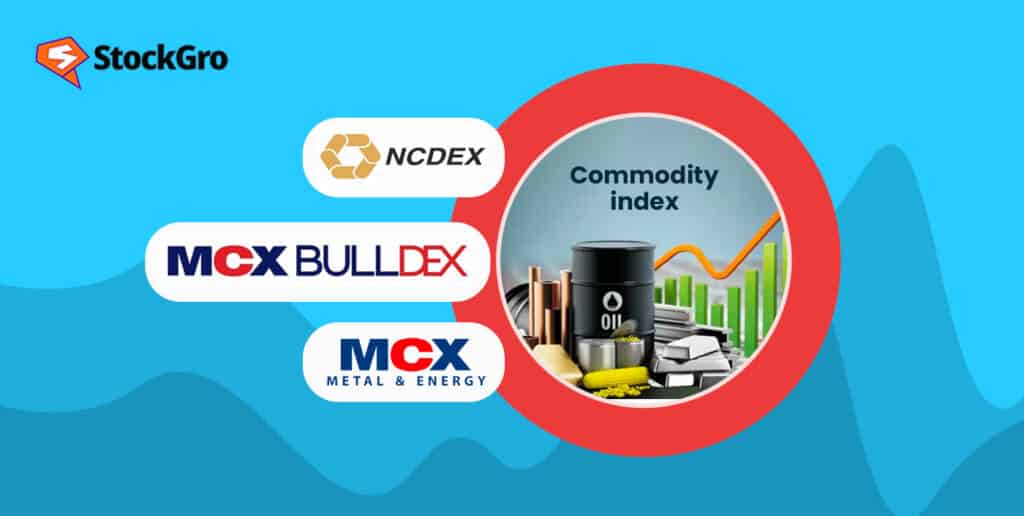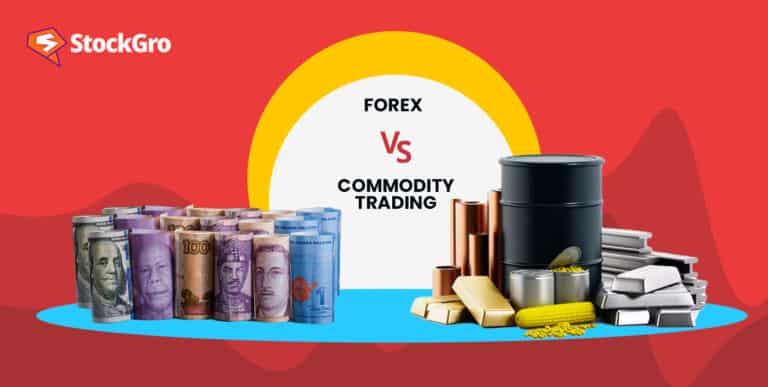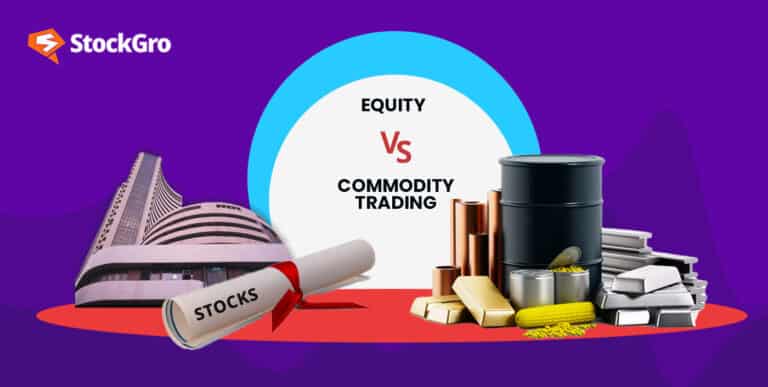
If you are familiar with the equity market, you likely know about indices like Nifty and Sensex. But what about commodity indices? Commodities are basic trade items like oil, wheat, or gold.
A commodity index monitors how a group of these commodities performs. It helps us understand their price changes and returns in the market. Want to know more about commodity indexes and their importance in finance? Continue reading.
What is a commodity?
A commodity is a product or material that is traded and is usually utilised as an essential component in the making of other goods or services. As defined by the Securities Contracts (Regulation) Act 1956, goods encompass a wide range of movable properties but exclude actionable claims, money, and securities.
Types of commodities in the derivatives market
Commodities in the derivatives market fall into two main categories: Agricultural and Non-Agricultural.
Agricultural commodities: These include perishable items like chana, cotton, guar seed, maize, soybean, and sugar. Processed agricultural goods, such as guar gum and palm oil, also fit into this category.
Non-agricultural commodities: These are natural resources that are mined or processed. They include:
- Bullion and gems: Highly valuable metals like gold and silver, along with gems like diamonds, make up this group primarily.
- Energy commodities: These are major energy sources, including both unprocessed forms like crude oil and natural gas and their refined forms or by-products.
- Metal commodities: This category covers non-precious metals that are mined or processed, such as aluminium, brass, copper, iron, lead, nickel, and zinc.
Understanding commodity index
A commodity index is a financial instrument that keeps track of the performance and prices of the underlying commodities. Unlike NIFTY or SENSEX, which focus on stock prices, commodity indices monitor individual or a combination of commodities. It’s important to understand that the value of each index changes according to the price changes of the commodities it includes.
No two commodity indices are exactly alike. They can focus on different sectors and have varying methods for weighing each commodity in the index. Some might treat all commodities equally, while others use more detailed approaches.
In short, commodity indices help investors see the bigger picture of how different commodities are performing.
You may also like: A beginner’s guide to understanding nifty sectoral indices
Commodity index Vs. other indices
A commodity index stands out because it solely relies on the price performance or capital gains of the commodities. This is different from bonds or mutual funds, where returns come from dividends or interest. With commodities, if a specific item’s price doesn’t go up, there’s no return for the investor.
The construction of commodity price index often follows unique rules. Some consider the physical market size of each commodity, which then influences the index’s weighting. This approach is distinct from other indices.
Another key difference lies in the life of contracts within a commodity index. These contracts expire, and to maintain the index, they are ‘rolled over’ to a new future date. This happens on pre-set ‘rollover days’. The rollover captures the difference in returns between two expiry dates, creating an opportunity for ‘roll return’. Roll return is the extra return beyond the price movement returns.
Also, commodity prices, influenced by trading platforms, affect broad segments of the economy. Changes in these prices can lead to social and political actions, like policy shifts or changes in demand. This makes the commodity index a crucial tool for tracking these influential price changes.
Also read: Difference between Nifty and Sensex
Commodity index India
Commodities have their own benchmarks similar to equities, such as: S&P world commodity index, CME commodity index and Bloomberg commodity index.
The commodity derivatives market in India is still in its early stages, unlike developed countries, where it is typically several times larger than the stock market.
Only after the merger of the Forward Markets Commission (FMC) with SEBI India allowed the creation of sectoral commodity indices. The Multi Commodity Exchange of India Limited (MCX) in 2019 launched the MCX iCOMDEX series. This includes
- Single Commodity Indices: Covers aluminium, lead, copper, zinc, gold, silver, crude oil and natural gas indices.
- Sectoral Indices:
- Base metal index (MCX METLDEX): Tracks metals like copper, nickel, zinc, aluminium and lead.
- Energy index (MCX ENRGDEX): Includes energy-related commodities such as natural gas and crude oil.
- Bullion index (MCX BULLDEX): Focuses on gold and silver.
- Composite Indices
The National Commodity & Derivatives Exchange Ltd. (NCDEX) in India also offers specific commodity indices like:
- NCDEX Agridex: It tracks the performance of ten liquid agricultural commodities.
- NCDEX Guarex: It’s based on liquid Guar gum and Guar seed futures contracts.
- NCDEX Soydex: It focuses on liquid Soybean and Refined Soy Oil futures contracts.
There is often confusion between the Nifty Commodities Index and the Commodity Index. It is essential to keep in mind that these two indices are not the same. The Nifty Commodities Index is equity-based and is designed to reflect the performance and behaviour of a diversified portfolio of companies that represent the commodities segment.
Also Read: Unlocking the power of index futures: A beginner’s guide
Trading in commodity indices
Trading in commodity indices offers several advantages for investors and traders. Here is why you should consider it:
- Commodity indices allow you to diversify your investments. They provide exposure to a variety of commodities, most of which don’t correlate well with other asset classes such as bonds and equities. This diversification can help in balancing your portfolio’s risk and return.
- A single commodity index contract reflects the price movement of its various constituents. This simplifies the process for investors who wish to invest in multiple commodities without the hassle of managing several contracts.
- Commodity indices settle in cash, eliminating the need for physical delivery of commodities. This makes trading more accessible and convenient.
- Trading in commodity indices can be a strategy to hedge against inflation, as commodities often react to changes in inflation rates.
- Investing in a commodity index can lower the volatility associated with exposure to just one commodity or sector. It helps in smoothing out the ups and downs of the market.
Final thoughts
Commodity indices are a smart choice for investors aiming to diversify and manage risk in their portfolios. They provide a clear view of market trends across various commodities, simplifying market navigation. It’s important to align these investments with personal financial goals and market expectations, ensuring a balanced and thoughtful approach to asset allocation.

